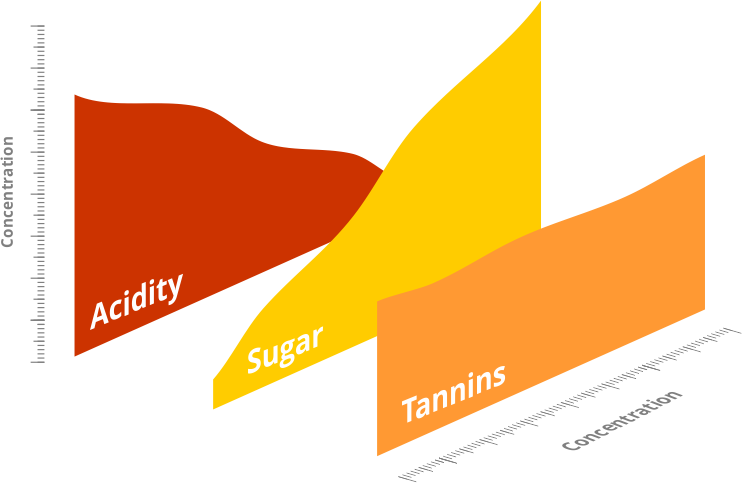Industrial revolution and technological change made a big impact on all jobs in vineyard and winery. Today winemaking in vineyard includes couple of main processes, which needs to be looked after by the winemaker or winegrower: bud break, blooming, fruit development, growing, ripening and finally harvesting.
Bud break
Bud break happens at around March in North Hemisphere. Vine is usually pruned before that in winter and during early spring months. When soil begins to warm, osmotic forces pushes water up from the root system of the vine. This water contains organic acids, minerals and sugars that wakens vine from “winter sleep”. For the grape fruit to set they need calm and sunny weather. Rain and cold stops fruits from setting and may lower level of harvest.
Growing
After the fruit setting grapes are starting to grow. During the months of June and July, based on the growing level, winemaker can already tell the size of the future harvest. Grape fruit growing needs enough warmth as well as rain. Ripening starts when grapes start to change its colour and last for approximately 40 days. Main factor for grape fruit ripening is sunlight and warmth. Photosynthesis happens during ripening phrase in green vine tree parts, during which sugar is produced. Acidity of the grape fruit lowers with the level of ripening, as well as aromas, tannins and anthocyanins develop.

Harvesting
Harvesting starts from late August till early October. This process it is one of the most crucial. Usually winemaker decides when to start harvest of the grapes because ripe level directly correlates to the future taste of wine. Harvest can be manual (by hands) or mechanical (by machines). After the harvest grapes are delivered to the winery where the winemaking process begins. Wine making stages in the winery are: sorting the grapes after harvest, crushing and pressing, fermentation, clarification, aging, bottling.
Sorting the grapes after harvest
Right after the harvest grapes are sorted – unripe, damage or rotten grapes, as well as leaves, brunches or even snails are removed. This stage allows direct increase in wine quality. Sorted grapes are ready to be crushed. For many years crushing was done manually by stomping the grapes with feet. Today it is mostly done mechanically and grapes are pressed into must. Must is a freshly pressed grape juice that contains skins, seeds and solids.
Crushing and pressing
For the white and rose wine production grape juice must be separated from the skins, seeds and solids. This is to prevent unwanted colour and tannins from leaching into the wine. For the production of a red wine they are left in contact with the skins to acquire flavour, colour, and additional tannins. The longer grape juice is in contact with skins, seeds and solids more colour and tannins wine might acquire.
Fermentation
After crushing and pressing, fermentation comes into play. Winemakers add desired yeast to the must. During the fermentation yeasts convers sugar, that is in the grape juice, into alcohol. Fermentation continues until all of the sugar is converted into alcohol and dry wine is produced. To create a sweet wine, wine makers will sometimes stop the process before all of the sugar is converted. Fermentation can take anywhere from 10 days to one month or even more.
Clarification
Clarification begins after fermentation stage is complete. Clarification is the process in which solids like dead yeast cells, tannins, or proteins are removed. Wine is transferred into a different vessel such as an oak barrel or a stainless steel tank depending on the final wine type that winemaker is producing. Aging and bottling is the final stage of the wine making process. Winemaker has a choice between bottling wine right away or aging it. Further aging can be done in bottles, stainless steel tanks, or oak barrels depending on winemaker’s choice and wine style.

